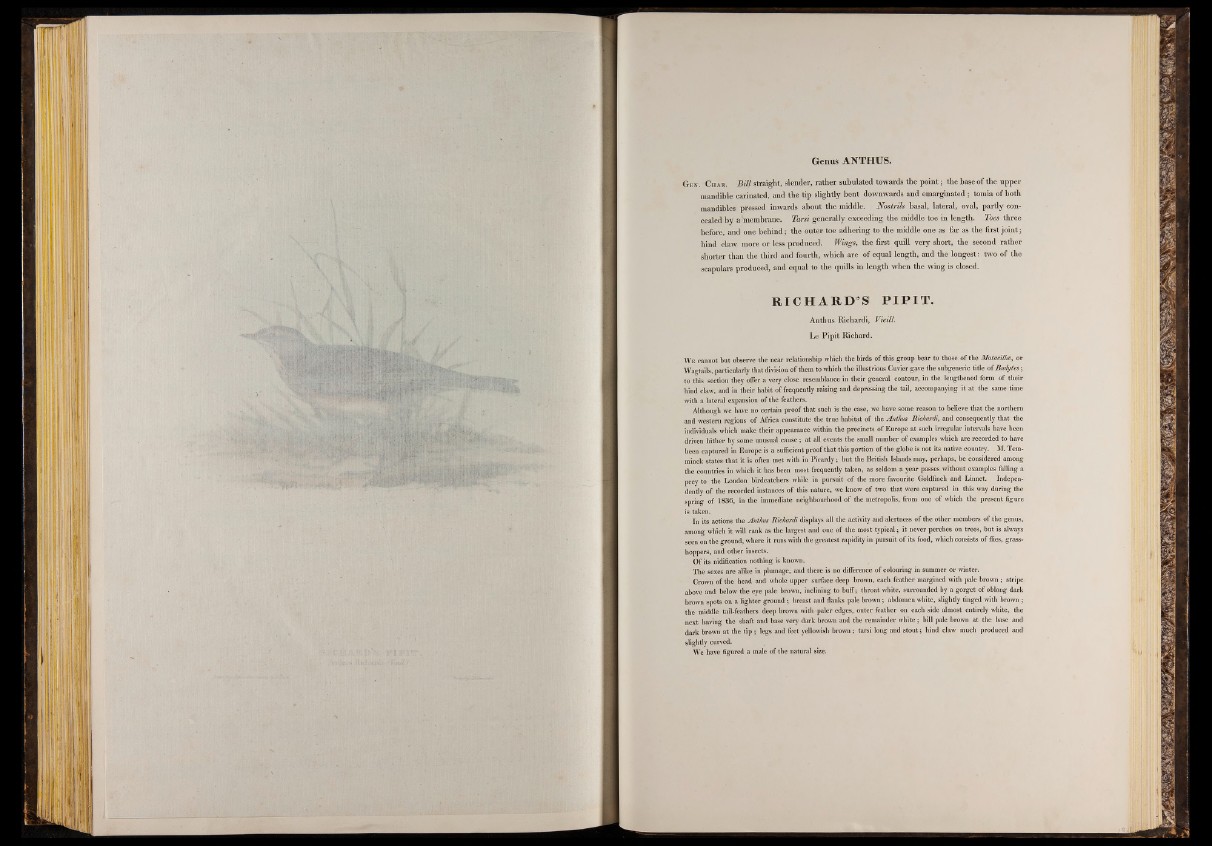
Genus ANTHUS.
Gen. Char. Bill straight, slender, rather subulated towards the p o in t; the base o f the upper
mandible carinated, and the tip slightly bent downwards and emarginated; tomia of both
mandibles pressed inwards about th e middle. Nostrils basal, lateral, oval, partly concealed
by a 'membrane. Tarsi generally exceeding th e middle toe in length. Toes three
before, and one behind; the outer toe adhering to the middle one as far as the first jo in t;
hind claw more or less produced. Wings, the first quill very short, the second rather
shorter than the third and fourth, which are o f equal length, and the longe st: two o f the
scapulars produced, and equal to the quills in length when the wing is closed.
R I C H A R D ’S P IP IT.
Antbus Richard i, Vieill.
Le Pipit Richard.
We cannot but observe the near relationship which the birds of this group bear to those of the Motacillas, or
Wagtails, particularly that division of them to which the illustrious Cuvier gave the subgeneric title of Budytes;
to this section they offer a very close resemblance in their general contour, in the lengthened form of their
hind claw, and in their habit of frequently raising and depressing the tail, accompanying it at the same time
with a lateral expansion of the feathers.
Although we have no certain proof that such is the case, we have some reason to believe that the northern
and western regions of Africa constitute the true habitat of the Anthus Richardi, and consequently that the
individuals which make their appearance within the precincts of Europe at such irregular intervals have been
driven hither by some unusual cause; at all events the small number of examples which are recorded to have
been captured in Europe is a sufficient proof that this portion of the globe is not its native country. M. Tem-
minck states that it is often met with in Picardy; but the British Islands may, perhaps, be considered among
the countries in which it has been most frequently taken, as seldom a year passes without examples falling a
prey to the London birdcatchers while in pursuit of the more favourite Goldfinch and Linnet. Independently
of the recorded instances of this nature, we know of two that were captured in this way during the
spring of 1836, in the immediate neighbourhood of the metropolis, from one of which the present figure
is taken.
In its actions the Anthus Richardi displays all the activity and alertness of the other members of the genus,
among which it will rank as the largest and one of the most typical; it never perches on trees, but is always
seen on the ground, where it runs with the greatest rapidity in pursuit of its food, which consists of flies, grasshoppers,
and other insects.
Of its nidification nothing is known.
The sexes are alike in plumage, and there is no difference of colouring in summer or winter.
Crown of the head and whole upper surface deep brown, each feather margined with pale brown ; stripe
above and below the eye pale brown, inclining to buff; throat white, surrounded by a gorget of oblong dark
brown spots on a lighter ground ; breast and flanks pale brown; abdomen white, slightly tinged with brown ;
the middle tail-feathers deep brown with paler edges, outer feather on each side almost entirely white, the
next having the shaft and base very dark brown and the remainder white; bill pale brown at the base and
dark brown at the tip ; legs and feet yellowish brown; tarsi long and stout; hind claw much produced and
slightly curved.
We have figured a male of the natural size.